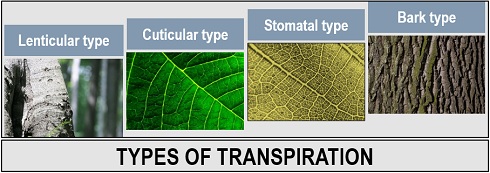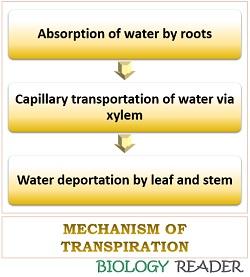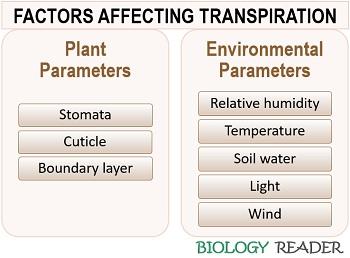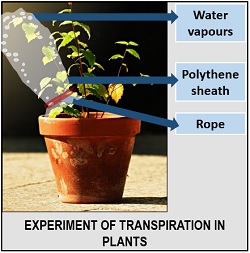Transpiration in plants is a process of water loss (in the form of water vapours) into the atmosphere from the leaf surface and stems. Plants undergo transpiration primarily to access carbon dioxide needed for photosynthesis and to cool themselves. As the plants are immobile, they manage their water needs by the two fundamental processes like water absorption and transpiration.
During water absorption, plants take up water from the root system via the xylem. In contrast, transpiration in plant expels excessive water from the leaf surface or stems into the atmosphere via specialized parts. Stomata and lenticels are the specialized parts of a plant that allow the flow of transpiration or water loss.
Potometer and other devices like lysimeter, porometer etc., are the types of equipment that can measure plants’ transpiration rate. In this context, definition, types, mechanism, factors affecting transpiration. You will also get to know the transpiration rate, transpiration experiment and significance.
Content: Transpiration in Plants
Definition of Transpiration in Plants
Transpiration in plants refers to the natural process in which a plant releases excessive water into the atmosphere as water vapours like a human body does. A human releases its excessive water through sweating, whereas transpiration is the term used in the case of plants.
Plants use nearly 5% of the water to fulfil their basic needs like food preparation and other cellular activities. Thus, a plant releases much water or transpires more because transpiration helps in:
- Maintaining the turgidity of the plant cells.
- Ingresses CO2 for photosynthesis.
- It also increases the nutrient uptake by a plant.
- Transpiration cools the plants by the exothermic release of energy in the form of vapours from the leaf cells into the atmosphere.
Transpiration Rate
It refers to the driving forces of the environment like humidity, light, temperature etc., that aid in expelling water from the plant components like stomata, cuticle, lenticels etc. A driving force is a potential difference between the soil and the atmosphere surrounding the plant.
In other words, the driving force refers to the difference in the potential of the leaf to uptake water from the roots via xylem and the potential of the atmosphere to uptake the evaporated water from the leaf cells.
Thus, water diffuses out of the leaves from a high water concentration to a low concentration region. As a result, drier is the air surrounding the leaves; the driving force of water to expel out of the leaves will increase.
There are stomata, cuticle, and lenticel resistances in a plant that restrict the water movement from the leaf into the atmosphere. Thus, a transpiration rate strongly depends upon the driving forces of the environment and the resistances of a plant. Transpiration rate is generally equated as:

We can predict the ease of transpiration through this equation by knowing the value of driving force and resistance. A high driving force results in a faster transpiration rate.
The greater value of resistance results in a slower transpiration rate. The unit of transpiration rate is the moles of water lost per leaf area per time (mol/cm2/s).
Types of Transpiration
A majority (90%) of transpiration occurs via leaf surface through a phenomenon called foliar transpiration. In addition, some plants transpire via stems through a phenomenon termed cauline transpiration. There are four types of transpiration:

- Lenticular transpiration: It refers to the type of water loss from the pores of older or woody stems (Lenticels). It accounts for 0.1% of the total water loss.
- Cuticular transpiration: It is a type of transpiration during which water loss occurs through the leaf cuticles. It accounts for 5-10% of the total water loss. The cuticle is the waxy coating or a fatty substance that covers the epidermis layer of the plant.
- Stomatal transpiration: It refers to the diffusion of water from the stomatal pore of the lower epidermis layer of the leaves. It accounts for 85-90% of the total water loss.
- Bark transpiration: Sometimes, transpiration occurs through the corky or hard covering of a stem called bark that has a high rate of transpiration than the lenticular type due to its large surface area.
Process of Transpiration in Plants
A mechanism of transpiration involves water absorption and water expulsion. Thus, the whole mechanism of transpiration involves:

- Root hairs are in direct contact with the soil, which uptake the existing water and mineral salts in the ground.
- Then, the root system facilitates absorption of water and conducts capillary transport of the water and minerals up to the plant’s shoot system via the xylem.
- Xylem transports the water to the mesophyll cells.
- The mesophyll cells of a plant possess large intercellular spaces to confine water.
- At the time of transpiration, water from the intercellular spaces diffuses into the sub-stomatal cavity in the form of water vapours.
- Finally, the water vapours escape into the atmosphere after the stomatal guard cell’s opening.
Factors Affecting Transpiration in Plants
Transpiration activity extensively depends upon the two factors, namely plant and environmental parameters.
Plant Parameters
It includes the stomatal, cuticle and boundary layer resistance, which decides the rate of transpiration.

Stomata: These are the pores found on the leaf surface and surrounded by the guard cells. It promotes gaseous exchange. A guard cell allows the exchange of gases by opening and closing activity and controls the water flow during transpiration. The greater number of leaves results in a higher number of stomata, thereby facilitating a high transpiration rate.
Cuticle: It exists as a waxy layer present above the leaf epidermis layer and acts as a barrier to the water movement out of leaves. Cuticle being waxy repels water and allows water vapours to enter.
Thus, the cuticle serves as a lipophilic or hydrophobic layer, through which the movement of water becomes difficult. In addition, the thickness of the cuticle decides the transpiration flow, i.e. more is the thickness of the cuticle, the slower will be the transpiration rate. Therefore, deciduous plants have much thicker cuticles.
Boundary layer: It refers to the thin layer of stagnant air surrounding the leaf surface, which varies with different plant species. At the time of transpiration, water vapours should diffuse from the boundary layer to the atmosphere.
With an increase in the boundary layer thickness, the transpiration rate slows down. Therefore, plants with hairy structures on their surface or large leaf size possess a more substantial boundary layer.
Environmental Parameters
It includes environmental factors like relative humidity, light, temperature etc., which can affect the driving force of the water loss.
Relative humidity: It is the amount of water vapour contained in the atmosphere. Reduction in relative humidity decreases the moisture content in the atmosphere and allow transpiration to occur more significantly. Therefore, a drier atmosphere promotes the water movement out of the plant due to the high driving force.
Temperature: The environmental temperature affects the magnitude of the driving force of water moving out of a plant. With the increasing temperature, the water holding capacity of that air also increases. Therefore, dry or warmer air will increase the driving force for water loss, whereas cooler air will decrease the driving force for transpiration.
Soil water: Soil also provides the source of water to carry out the transpiration process. If a plant contains a sufficient amount of soil moisture, it will transpire at higher rates through the continuous water supply from the soil via root hairs.
Light: Stomata tends to open in the presence of light, which allows the entry of available carbon dioxide for photosynthesis. In the absence of light, most plants have a closed stoma. Therefore, light is needed in the transpiration process to trigger the stomata for facilitating the gaseous exchange between plant and environment.
Wind: It can affect transpiration rate by eliminating or reducing the boundary layer surrounding the leaf surface. Wind increases the transpiration or water loss from the leaf surface to the atmosphere. As it reduces the boundary layer, the movement of water to condense with the atmosphere becomes shorter.
Transpiration Experiment
We can understand the concept of transpiration by performing a simple experiment by taking a well-potted plant. To prevent water evaporation, cover the plant with a polythene sheath and tie it with a rope.
 After some time, the water released by the plant will appear on the top inner surface of the polythene sheath. A film of water droplets condenses on the polythene sheath, represent the transpiration activity of a plant, during which the water releases in the form of vapours.
After some time, the water released by the plant will appear on the top inner surface of the polythene sheath. A film of water droplets condenses on the polythene sheath, represent the transpiration activity of a plant, during which the water releases in the form of vapours.
Significance
Transpiration is an important event, during which a plant releases out the excess water by the various plant resistances like stomata, lenticels etc., through the driving environmental forces. Therefore, transpiration is an expulsion of water from the plant surfaces (via leaves and stems) in the form of vapours (condense in the atmosphere).
A vote of thanks goes to the researching team for the great work done here. I really appreciate it. Thanks so much because I got what I wanted.